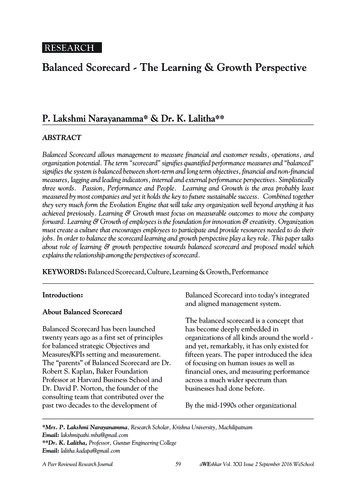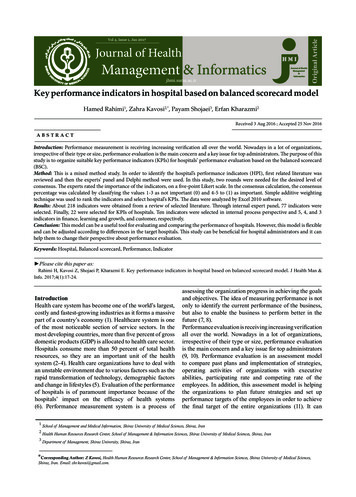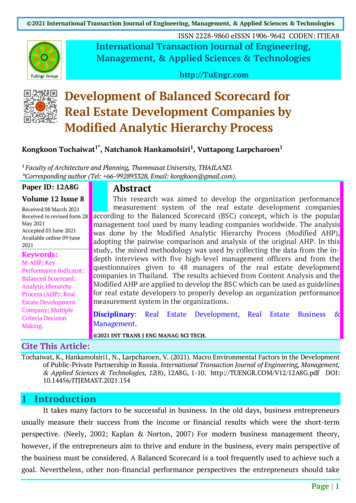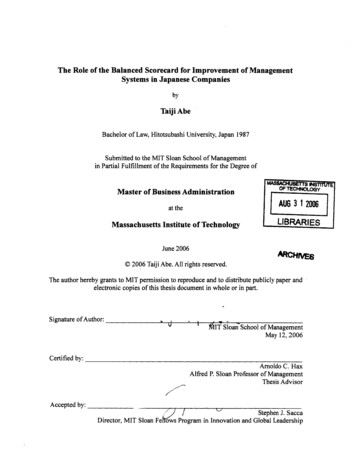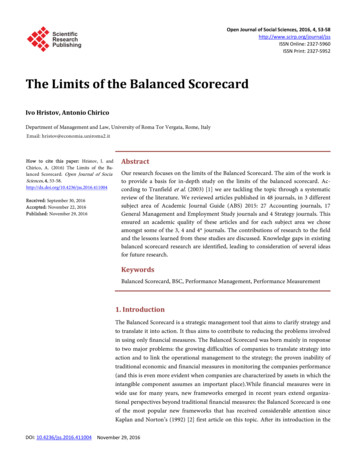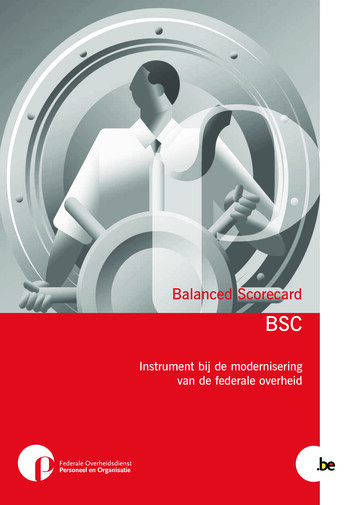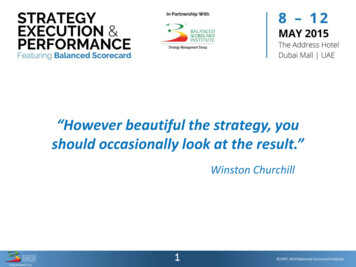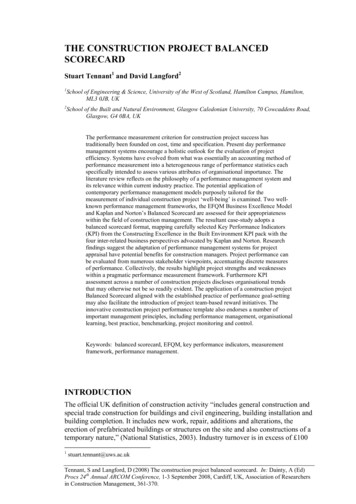
Transcription
THE CONSTRUCTION PROJECT BALANCEDSCORECARDStuart Tennant1 and David Langford21School of Engineering & Science, University of the West of Scotland, Hamilton Campus, Hamilton,ML3 0JB, UK2School of the Built and Natural Environment, Glasgow Caledonian University, 70 Cowcaddens Road,Glasgow, G4 0BA, UKThe performance measurement criterion for construction project success hastraditionally been founded on cost, time and specification. Present day performancemanagement systems encourage a holistic outlook for the evaluation of projectefficiency. Systems have evolved from what was essentially an accounting method ofperformance measurement into a heterogeneous range of performance statistics eachspecifically intended to assess various attributes of organisational importance. Theliterature review reflects on the philosophy of a performance management system andits relevance within current industry practice. The potential application ofcontemporary performance management models purposely tailored for themeasurement of individual construction project ‘well-being’ is examined. Two wellknown performance management frameworks, the EFQM Business Excellence Modeland Kaplan and Norton’s Balanced Scorecard are assessed for their appropriatenesswithin the field of construction management. The resultant case-study adopts abalanced scorecard format, mapping carefully selected Key Performance Indicators(KPI) from the Constructing Excellence in the Built Environment KPI pack with thefour inter-related business perspectives advocated by Kaplan and Norton. Researchfindings suggest the adaptation of performance management systems for projectappraisal have potential benefits for construction managers. Project performance canbe evaluated from numerous stakeholder viewpoints, accentuating discrete measuresof performance. Collectively, the results highlight project strengths and weaknesseswithin a pragmatic performance measurement framework. Furthermore KPIassessment across a number of construction projects discloses organisational trendsthat may otherwise not be so readily evident. The application of a construction projectBalanced Scorecard aligned with the established practice of performance goal-settingmay also facilitate the introduction of project team-based reward initiatives. Theinnovative construction project performance template also endorses a number ofimportant management principles, including performance management, organisationallearning, best practice, benchmarking, project monitoring and control.Keywords: balanced scorecard, EFQM, key performance indicators, measurementframework, performance management.INTRODUCTIONThe official UK definition of construction activity “includes general construction andspecial trade construction for buildings and civil engineering, building installation andbuilding completion. It includes new work, repair, additions and alterations, theerection of prefabricated buildings or structures on the site and also constructions of atemporary nature,” (National Statistics, 2003). Industry turnover is in excess of 1001stuart.tennant@uws.ac.ukTennant, S and Langford, D (2008) The construction project balanced scorecard. In: Dainty, A (Ed)Procs 24th Annual ARCOM Conference, 1-3 September 2008, Cardiff, UK, Association of Researchersin Construction Management, 361-370.
Tennant and Langfordbillion per year, GDP is above 8%, (DTI, 2005) and an estimated 2.2 million peopleare employed in the UK construction sector, (HSE, 2006). Industry statistics both interms of turnover and employment positions the construction sector as an economicbarometer and indicator of domestic well-being. A fact commonly acknowledged bythe UK Government, commenting that “the sector has a profound influence over ourquality of life at home and at work,” (DTI, 2002). However, the DTI (2002) have alsostated that the performance of the construction sector must improve. The UKconstruction industry has a long history of reports bemoaning the level ofperformance, (Leiringer et al., 2005). In the past the construction industry has beenaccused of being wasteful, inefficient and ineffective, (Beatham et al., 2004).Research RationaleTraditional performance management systems typically emphasise corporate levels ofpredominately financial achievement based on annual results. The short to mediumterm construction timescales and temporary relationships that characterise a largelyproject-based industry may be better evaluated by a performance paradigm thatencapsulates qualitative as well as quantitative measures of success. The objective ofthe research programme is to adopt a contemporary performance managementphilosophy; utilise existing ‘hard’ and ‘soft’ key measurement protocols, to isolateconstruction project performance and evaluate project success within a pragmaticperformance template.PERFORMANCE MANAGEMENTOver the past decade corporate interest in performance management has evolved fromwhat was essentially an accounting system of performance measurement in to aneclectic range of performance statistics. Historically, organisational performancecriterion has focused first and foremost on the financial aspects of businessachievement, (Eccles, 1991; Kaplan and Norton, 1993 and Crowther, 1996). Theemergent industrial society of the nineteenth century witnessed the increasingstandardisation of financial accounting practice driven by Government Taxation,corporate liability and other stakeholder bodies. Over the coming decades asophisticated system of accounting protocol evolved in an effort to regulate procedureand coordinate the manner in which financial information was disseminated. Thisapproach to performance measurement was satisfactory whilst corporate tradingremained straightforward. By the 1970’s changes in manufacturing and increasedglobal competition started to create different demands on organisations. During the1980’s commerce began to realise that dimensions of quality and total qualitymanagement values could be considered as a strategic intent in their quest forcompetitive advantage. The subsequent development and implementation of qualitymeasures represented the most positive step taken in recent times to broaden businessperformance measurement mindset, (Eccles, 1991). This represented a shift inperformance doctrine, moving away from a predominately financial accounting modeltowards a contemporary perspective, matching operational economy and efficiencywith corporate effectiveness and ethics.Contemporary Performance Management ModelsA holistic approach to performance management assumes that multiple stakeholdersmust be satisfied simultaneously, (Open University, 2001). Two of the best knowncontemporary performance management frameworks are the EFQM Excellence Modeland Kaplan and Norton’s Balanced Scorecard. The underlying philosophy of both362
Project performance measurementmodels is very similar; “each consists of a non-prescriptive template offeringmanagers a relatively small number of categories of key performance metrics to focuson,” (Wongrassamee et al., 2003).The EFQM Excellence ModelThe first European quality model was created in 1988 and first launched in 1991.Developed by fourteen leading European companies the objective was to promotecorporate excellence as a response to the increasing competitive pressures of a globalmarket place. The European Foundation for Quality Management's (EFQM) businessexcellence model highlights the necessity for a holistic approach to performanceenhancement, (Open University, 2001). Its popularity has continued to grow and “byJanuary 2003, EFQM membership had grown to around 800 organisations from mostEuropean countries and most sectors of activity,” (EFQM, 2003). The model is basedupon eight fundamental concepts of sustainable excellence.They are: 1/ Results Orientation; 2/ Customer Focus; 3/ Leadership and Constancy ofPurpose; 4/ Management by Processes and Facts; 5/ People Development andInvolvement; 6/ Continuous Learning, Innovation and Improvement; 7/ PartnershipDevelopment and 8/ Corporate Social Responsibility.EFQM suggest that the “Excellence Model is a practical tool that can be used in anumber of different ways: As a tool for self-assessment As a way to benchmark with other organisations As a guide to identify areas for improvement As the basis for a common vocabulary and a way of thinking As a structure for the organisation's management system’’ (EFQM, 2006).The model has nine criteria, broken down in to five enabling activities (leadership,people management, policy and strategy, partnership and resources and finallyprocesses) which drive four areas of results (people results, customer results, societyresults and key performance results). The model also has feedback in the form ofinnovation and learning which stimulates leadership and the other four enablers whichin turn drive results, producing more feedback and completing the continuousimprovement loop. The EFQM Excellence Model is a ‘live’ framework where EFQMcontinually update the model to reflect changing business needs and managementthinking.The Balanced ScorecardIn recognition of the increasingly complex commercial environment company chiefexecutives wanted innovative ways to articulate corporate well-being. In response tothis management challenge Robert S. Kaplan and David P. Norton (1992) devised the‘Balanced Scorecard’. The assertion of the Balanced Scorecard was to construct a setof four interrelated measures that give senior managers a fast and comprehensiveinformation model that is representative of corporate strategy, business objectives andcompetitive demands. Financial information on its own is backward looking,commenting on previous performance without predicting future achievements. Thebalance scorecard supplements the conservative financial viewpoint with threeforward thinking business perspectives, namely; customer perspective, internalbusiness perspective and an innovation and learning perspective. The four business363
Tennant and Langfordviewpoints create a more ‘rounded’ approach to performance assessment,acknowledging the importance of the various stakeholders, including the customer andconsumer. Kaplan and Norton (1992) stress that the balanced scorecard presents across-functional shortlist of key indicators for present and future performance,emphasising that the Balanced Scorecard “provides answers to four basic questions: How do customers see us? (customer perspective)What must we excel at? (internal perspective)Can we continue to improve and create value? (innovation and learningperspective)How do we look to shareholders? (financial perspective).”Even though the four business perspectives are established, the actual content of thebalanced scorecard is indeterminate. The balanced scorecard is not a template that canbe applied across industry sectors or companies in general. Diverse market conditions,corporate strategies and competitive environments require different scorecards,(Kaplan and Norton, 1993). Companies are required to customise the scorecard to bestrepresent their specific corporate desires in terms of vision, structure, technology andculture. An underlying rationale of the balanced scorecard is to communicate strategicperformance, permeating the various layers of administration in a manner that iscomprehensible and constructive to those involved in the tactics of operationalperformance. There is also a strong human relations aspect to the successfulimplementation of the scorecard. This concurs with recent developments in workplaceecology and in particular the increased adoption of team-based working. The balancedscorecard “approach to performance measurement is consistent with initiatives underway in many companies: cross-functional integration, customer-supplier partnerships,global scale, continuous improvement and team rather than individual accountability,”(Kaplan and Norton, 1992).PERFORMANCE MEASUREMENTThe objective of modern performance measurement techniques is to translate broadermanagement ideals in to specific measurable achievements. Mainstream accountingprocedures have been off-set against alternative mechanisms of key performancemeasurement, collectively known as Key Performance Indicators, (KPI’s). It isnoteworthy to comment that many companies have a large number of keyperformance measures of which only a few – and sometimes none – are actuallyadopted by management to measure performance. “It is not the number and reach ofthe measures that is most important. It is the relevance,” (Roest, 1997). There is also agrowing acceptance that for KPI’s to be meaningful they need to be incorporatedwithin a performance management system, (Beatham et al., 2004).The UK Construction Industry and KPI’sIn response to the increased criticism by construction clients the UK Government setup a ‘Construction Task Force’ to investigate and report on the efficiency and qualityof UK construction from a customer’s perspective. In 1998 Sir John Egan publishedhis findings, entitled ‘Rethinking Construction’. A core declaration was the need to settargets for improving industry performance, stating that “to drive dramaticperformance improvement the Task Force believes that the construction industryshould set itself clear measurable objectives, and then give them focus by adoptingquantified targets, milestones and performance indicators,” (Egan, 1998). To supportthe development of performance measurement techniques and sponsor industry-wide364
Project performance measurementbenchmarking programmes the Government set up ‘The Key Performance Indicator(KPI) Project Management Group’. This specialised group, representing a crosssection of industry stakeholders have over the past nine years, under various workingparty guises, developed a comprehensive hierarchy of construction Key PerformanceIndicators (KPI’s). The KPI’s first published in 1999 are a live, year-on-year’commentary of industry performance. They continue to be developed and refined asmore companies adopt the values and participate with the necessary data gatheringagainst which industry-wide benchmarks can be established and reported. KPIcalculation, information dissemination and guidance are currently provided by theGovernment sponsored task-force, Constructing Excellence in the Built Environment.To assist companies in their acceptance of the performance measurement techniques,exemplars for data gathering surveys, data analysis and data calculation are availablewith further support accessible via regional workshops and KPI road shows. As part ofthe evolution of industry KPI’s, distinct sectors within the industry, such as ‘Housing’,‘Consultants’ and ‘Materials’ as well as ‘Social’ (Respect for people) and‘Environmental’ KPI themes have been developed as part of the overall hierarchy ofconstruction industry performance measurement. The existing suite of constructionKPI’s offer companies “a framework to benchmark activities both at a broad level,and at a level much closer to the ‘coal face’,” (Raynsford, 1999).Project Performance ModelThe EFQM model is a corporate management tool designed to help organisationsimprove performance, (Thorpe and Sumner, 2004). At the heart of the EFQM businessexcellence model is the notion of self-assessment using questionnaires, self-audits andbenchmarking. The implementation of the EFQM framework involves the ‘whole’company and “does not explicitly emphasise a project focus,” (Bassioni et al., 2005).At present ‘Constructing Excellence’ KPI profiles address only six of the eightfundamental concepts referred to in the EFQM model, (Beatham et al., 2004). As aconsequence the framework would require extensive customisation to accommodate adistinctly project performance orientation. Adoption of the model out with theprescribed assessment criteria could undermine the veracity of the resultant outcomes.For this reason there would always be an unacceptable degree of research riskassociated with the adoption of the EFQM blueprint. The balanced scorecard in itsoriginal format is aptly suited to the measurement of bespoke projects. The holisticethos could be embraced with carefully chosen KPI’s. The underlying principles ofthe Balanced Scorecard could be employed with confidence for the performancemeasurement of a ‘work in progress’ construction project. Due to the ease of researchfit between the model, the Constructing Excellence KPI’s and construction projectinformation sources, the Balanced Scorecard was chosen as the most appropriateperformance management system. The financial perspective traditionally viewed as a‘lagging’ measure would capture a snapshot of performance to date. The other threeperspectives may be considered as ‘leading’ measures. The function of ‘leadingmeasures’ is to establish current levels of achievement that may significantlyinfluence future performance. For the evaluation of project performance sevenindividual Key Performance Indicators, four from the ‘Economic - All Construction’KPI’s and three from ‘Respect for People’ KPI’s were selected for inclusion withinthe balanced scorecard, (see Table 1).365
Tennant and LangfordTable 1: KPI Balanced Scorecard Perspective AppraisalFINANCIALPredictability: Construction CostPredictability: Construction TimeINTERNALEmployee SatisfactionHours (worked per day)EXTERNALClient Satisfaction: ServiceClient Satisfaction: ProductINNOVATION & TRAININGTraining (Days per year)In an effort to incorporate positive features of the EFQM Model, selection appraisal ofthe KPI’s accommodate ‘leading’ as well as ‘lagging’ indicators in conjunction withobjective and subjective measures of efficiency, (see Table 2).Table 2: KPI ‘EFQM’ Selection ging Indicators’Predictability: Construction CostPredictability: Construction TimeClient Satisfaction: Product‘Leading Indicators’Training (Days per year)Hours (worked per day)Client Satisfaction: ServiceEmployee SatisfactionThe resultant project performance research model assimilates seven key performanceindicators to produce a customised suite of ‘Pan-Project’ key performance measures.THE CASE STUDYThe case study and data collection phase of the research programme was carried outbetween June 2004 and April 2005. The research enlisted the cooperation of threemajor UK construction contractors, Company B, C and D and comprised of thirteenseparate construction projects. A pilot study, Company A, Project 1 (A/1) has beenomitted due to the evolving attributes of the methodology and experimental nature ofthe pilot case study. Key project performance measurement data was collected usingquestionnaires from various project stakeholders including the Project Manager,Client Representative and individual Project Team Members. The results weretransposed in to industry benchmark scores using the appropriate 2004 KPI Wallcharts published by Constructing Excellence in the Built Environment.THE RESULTSThe seven benchmarked key performance indicator percentages for each of theparticipating construction site projects are presented in Table 3. A mean KPI value foreach of the selected KPI’s is presented in the right-hand column (KPI Mean). A meanperformance score for each of the participating projects is illustrated across the bottomrow (Project KPI Mean).366
Project performance ceIndicatorPredictabilityConstruction CostPredictabilityConstruction TimeClientSatisfaction ServiceClientSatisfaction ProductEmployeeSatisfactionHours Worked(per week)Training Days(per year)Project KPIMeanProjectB/1Table 3: Project Balanced 193888854482943607059394042637459DATA INTERPRETATIONThe interpretation of results is often viewed as a critical stage in researchmethodology, particularly in relation to performance management studies.Nonetheless a key component of this research objective was the compilation ofperformance data beyond the traditional limitations of cost, time and specification.The process of data gathering was central to the concept of a construction projectbalanced scorecard. The outcome has been very successful with case-study projectspresenting a set of industry related benchmarks that encompass four different businessperspectives capturing various project stakeholder interests. Data interpretation canadopt two divergent viewpoints, project appraisal and KPI assessment.Project AppraisalProject appraisal involves the examination of individual project performance incomparison with other project performance scores. Project appraisal within companyparameters reveal that project D/4 records the highest mean benchmark score of 74%compared with project D/1 which recorded the lowest company ‘D’ mean value of40%. From a visual inspection it is evident that performance values regardingpredictability, client satisfaction and employee satisfaction significantly compromisesthe overall judgment of project D/1. Casual evaluation of the data may be furtherdeveloped by carrying out statistical investigation to establish patterns of projectperformance. For example is project D/1 and D/2 performing significantly differentlyfrom D/3, D/4 and D/5? Information of this nature on a construction project prior tocompletion would allow for timely management intervention in an effort addressproject-specific issues.KPI AssessmentData interpretation may also compare various key performance indicators. Thisapproach highlights the strengths and weaknesses associated with overall project367
Tennant and Langfordperformance. For project D/4 the predominant strength is client satisfaction (externalperspective). Training (innovation and training perspective) is also a notableachievement with predictability cost and time (financial perspective) also recordingabove average indicator results. The only perceptible weakness is the KPI representingworking hours per week. The results suggest that working hours for project D/4 is notperforming significantly differently from other projects (project appraisal) but ifmanagement wished to improve the overall performance of project D/4 then theworking hours KPI would offer the greatest potential for improvement. Project B/3 isat the other end of the performance spectrum. Only training days per year records aseemingly satisfactory benchmark score. Preliminary target areas for a project B/3improvement strategy would focus on enhancing client satisfaction coupled withbetter predictability. The KPI results may also be a reflection of organisationalattributes. From the results, company ‘B’ would appear to focus on cost and timepredictability, whereas both company ‘C’ and ‘D’ demonstrate greater clientawareness. The seemingly contradictory evidence, reasonable predictability coupledwith low levels of client satisfaction (Company ‘B’) and poorer predictability coupledwith high levels of client satisfaction (Company ‘C’ and ‘D’) is a timely reminder thata key factor for the meaningful evaluation of performance measurement techniques iscareful interpretation.DISCUSSIONThe construction project balanced scorecard challenges the traditional performancemeasures of cost, time and specification in a number of thought provoking ways. Themost obvious attribute of the contemporary approach is the inclusion of objective(quantitative measures) and subjective (qualitative measures) within a ‘live’framework that affords an opportunity for change. Traditional performancemeasurement techniques are lagging measures of what has been accomplished.Measures of this type are outcome orientated. The criticism of a key performanceoutcome is that the assessment of past achievement is made with little indication forfuture performance. Whereas indicators suggest there may be a potential benefit stillto be realised from the evaluation of current data. Some of the indicators advocated byConstructing Excellence in the Built Environment are by definition key performanceoutcomes, (KPO’s). The discussion is not necessarily about semantics butpractitioners do need to be aware of the subtle differences between KPI’s and KPO’sespecially when advocating the introduction of a performance management system.For example defects, profitability, productivity, safety, construction cost andconstruction time are dependent on end of project data, i.e. KPO’s. By utilising theremaining four headline KPI’s, namely; predictability – cost, predictability – time,client satisfaction – service, client satisfaction – product, balanced with respect forpeople indicators such as employee satisfaction, working hours and training days asnapshot measurement and evaluation of project ‘well-being’ can be successfullyundertaken. Subsequent interpretation of the KPI results offer management a valuableproject insight. As a consequence information of this nature may provide direction andjustification for future decision-making policy. With particular reference to projectB/3, identifying poor client satisfaction in week 27 of a 64 week construction contracthighlights an obvious opportunity for positive intervention. To continue withoutaddressing the issue may be regarded as short-sighted and representative of outdatedbehaviours that focus on traditional values of time and money to the detriment ofrelationship building and soft skills management. A corporate wide application of a‘live’ project balanced scorecard not only highlights strengths and weaknesses368
Project performance measurementassociated with each unique construction site but it may also accentuate companywide performance patterns. Results from the case-study illustrate various constructionproject qualities. The adoption of an overarching performance management systemcoupled with carefully selected KPI’s give construction practitioners a performanceframework against which they can evaluate, compare and benchmark key indicators offuture project performance. Other potential applications of a holistic project scorecardexist. In particular reward management and the introduction of team reward systems.Not in itself a new topic but one frequently rejected in favour of an orthodox,individualistic approach to managing people. To this extent the development of a teamremuneration incentive scheme congruent with the implementation of a balanceproject performance scorecard would be a logical and challenging direction for bothconstruction managers and human resource management.CONCLUSIONTo date the implementation of KPI’s within the construction sector has been limited,often utilised for marketing purposes as opposed to an integral part of businessacumen, (Beatham et al., 2004). The idea of a construction project performancebalanced scorecard is therefore an interesting proposition. “The scorecard is not just ameasurement system, it is a management system to motivate breakthroughcompetitive performance,” (Kaplan and Norton, 1993). The construction projectbalanced scorecard successfully captures the ethos of a contemporary performancemanagement model coupled with a pragmatic measurement template that others canuse.REFERENCESBassioni, H.A., Price, A.D.F. and Hassan, T.M. (2005) Building a conceptual framework formeasuring business performance in construction: an empirical evaluation.Construction Management and Economics, 23(6), 495-507.Beatham, S., Chimay, A. and Thorpe, T. (2004) KPIs: a critical appraisal of their use inconstruction, Benchmarking, 11(1), 93–117.Crowther, D.E.A. (1996) Corporate performance operates in three dimensions, ManagerialAuditing Journal, 11(8), 4–13.DTI (2005) Construction Sector Unit Annual Report 2004 / 2005, HMSO, London.DTI (2002) Rethinking Construction Innovation and Research: A Review of Government R &D Policies and Practices, HMSO, London.Eccles, R.G. (1991) The performance measurement manifesto, Harvard Business Review, Jan/ Feb., 131–137.EFQM (2006) The EFQM Excellence Model. Available at URL:http://www.efqm.org/Default.aspx?tabid 35 (Accessed July 22nd. 2006).EFQM (2003) EFQM: Introducing Excellence, EFQM.Egan, J. (1998) Rethinking Construction, HMSO, London.HSE, (2006) Health and Safety in the Construction Industry. Available URL:http://www.hse.gov.uk/construction/index.htm (Accessed, August 2nd. 2006).Kaplan, R.S. and Norton, D.P. (1993) Putting the balanced scorecard to work, HarvardBusiness Review, Sept / Oct., 134–147.Kaplan, R.S. and Norton, D.P. (1992), The balanced scorecard: Measures that driveperformance, Harvard Business Review, Jan / Feb., 71–79.369
Tennant and LangfordLeiringer, R., Fernie, S. and Ramboll, N.S. (2005), Adopting Partnering in Sweden: A CriticalPerspective, CIB W65 Conference Proceedings, 7, 42-53.National Statistics (2003) UK Standard Industrial Classification of Economic Activities 2003,National Statistics Publications, HMSO, London.Open University, (2001) Management Control and Beyond: A Holistic Approach toPerformance Improvement, The Open University, Milton Keynes.Raynsford, N. (2000) KPI Report for the Minister for Construction, DETR, London.Roest, P. (1997) The golden rules for implementing the balanced business scorecard,Information Management & Computer Security, 5(5), 163–165.Thorpe, B. and Sumner, P. (2004) Quality Management in Construction, Gower PublishingLtd, Hants, UK.Wongrassamee, S., Simmons, J.E.L. and Gardiner, P. D. (2003) Performance measurementtools: the Balanced Scorecard and the EFQM Excellence Model, Measuring BusinessExcellence, 7(1), 14–29.370
(KPI) Project Management Group'. This specialised group, representing a cross-section of industry stakeholders have over the past nine years, under various working-party guises, developed a comprehensive hierarchy of construction Key Performance Indicators (KPI's). The KPI's first published in 1999 are a live, year-on-year'


